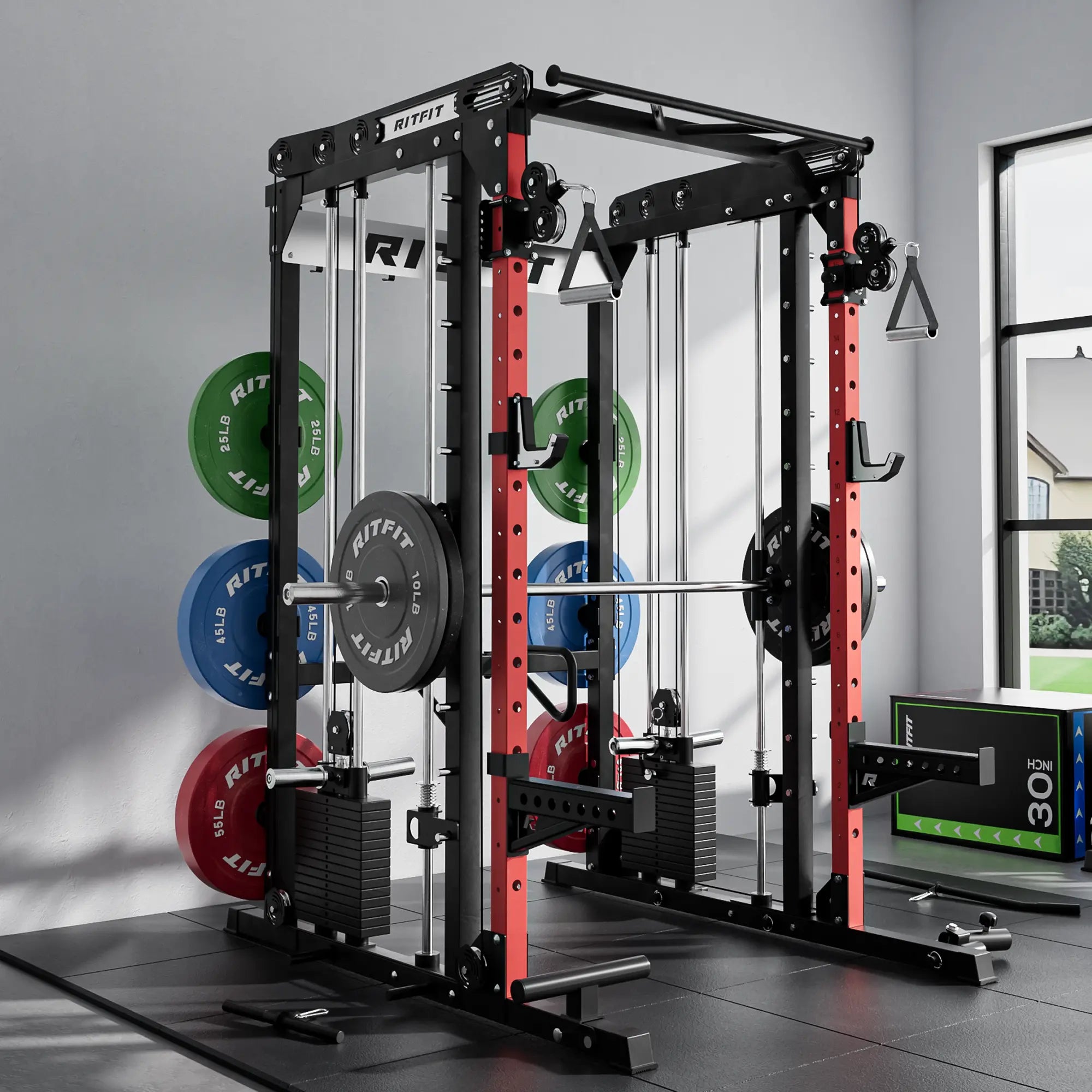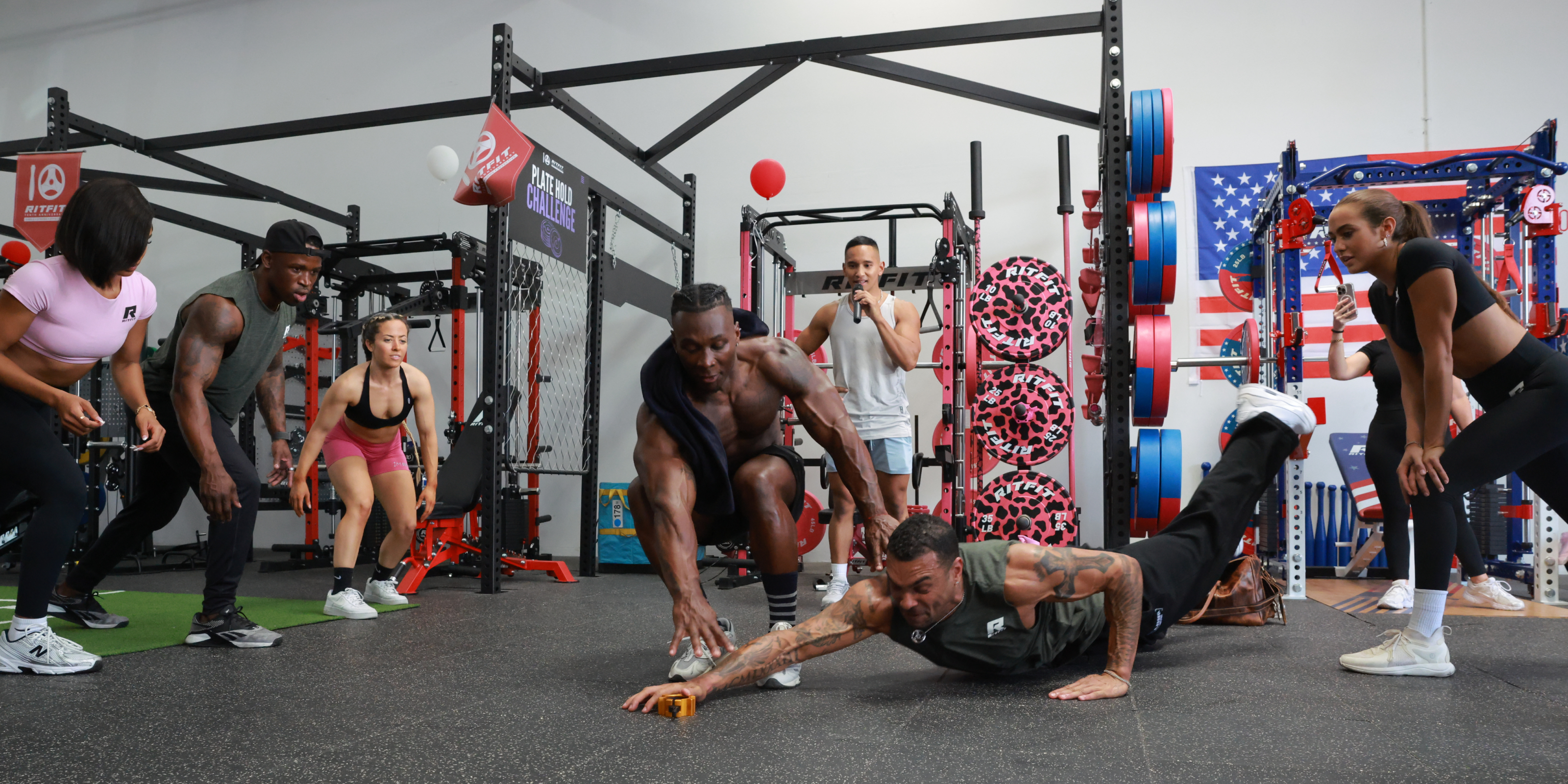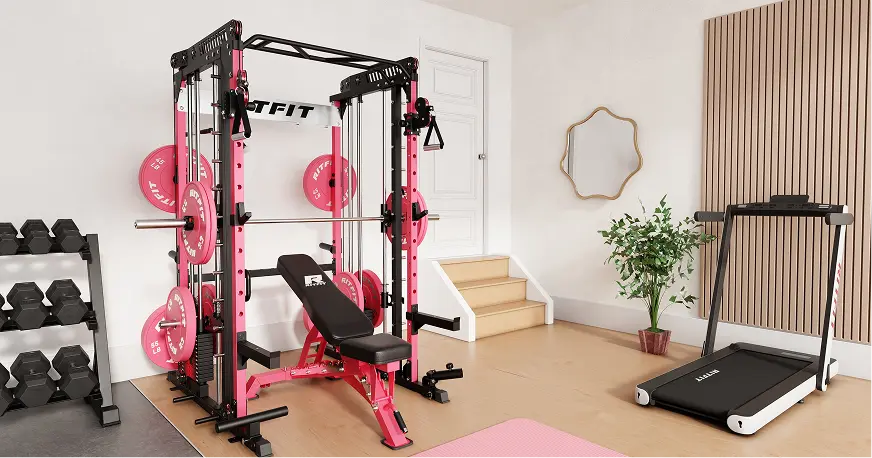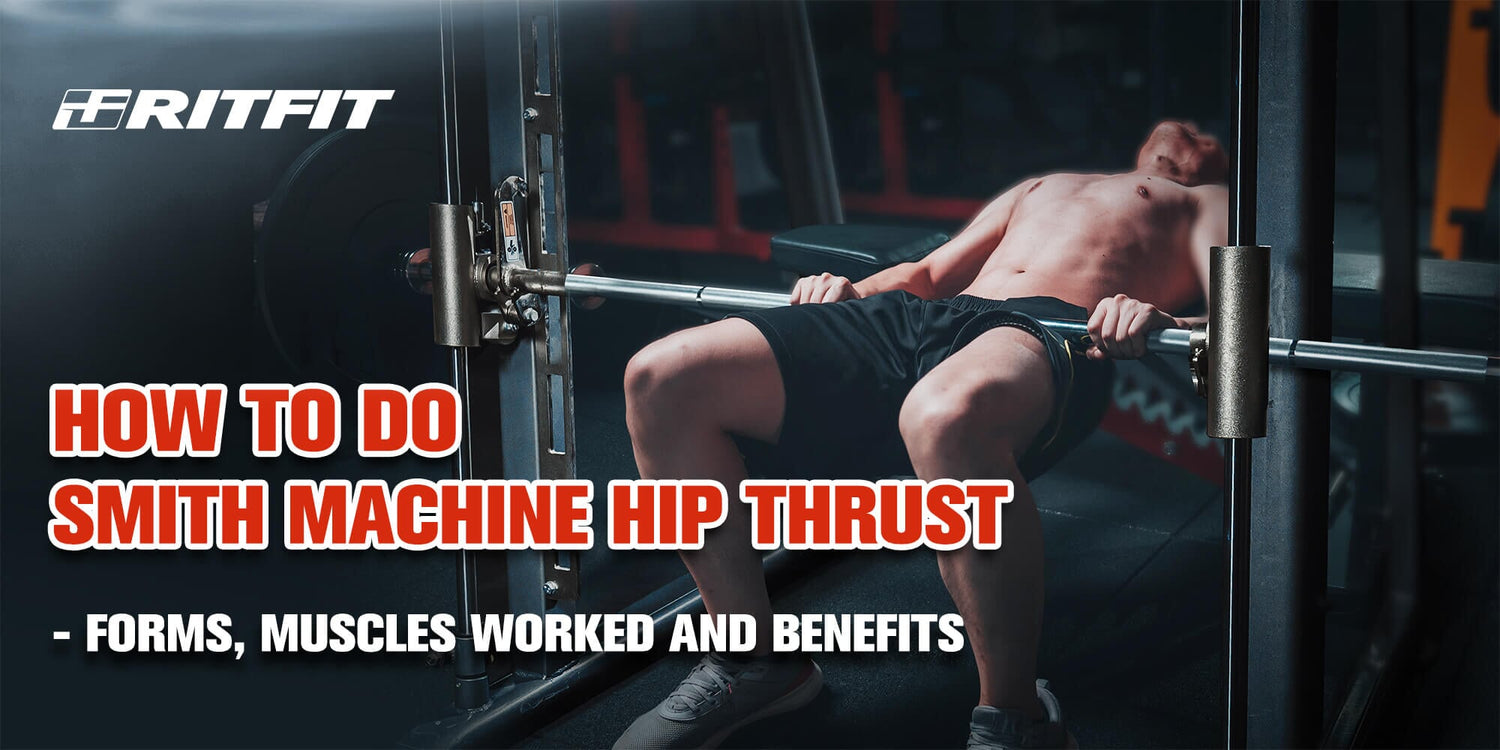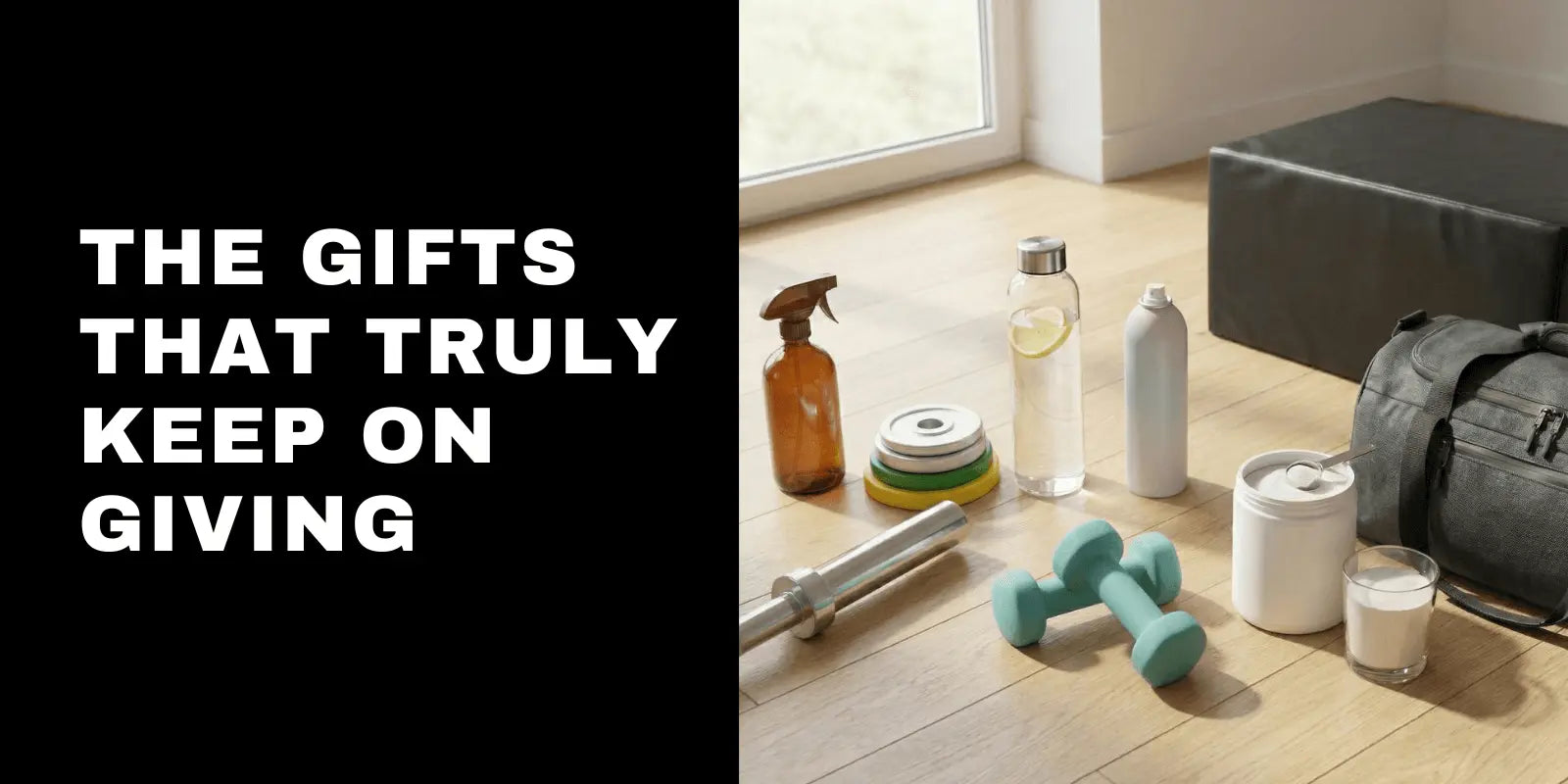Table of Contents
- What is A Smith Machine?
- What is A Hip Thrust?
- How to Set Up Hip Thrust on Smith Machine
- How to Do the Smith Machine Hip Thrust with Proper Form
- How to Program Smith Machine Hip Thrusts
- Muscles Worked by the Smith Machine Hip Thrust
- Benefits of the Smith Machine Hip Thrust
- Common Smith Machine Hip Thrust Mistakes (and How to Fix Them)
- Recommended Training Gear for Smith Machine Hip Thrusts
- Smith Machine Hip Thrust Alternatives
- Smith Machine Hip Thrust vs. Barbell Hip Thrusts
The Smith Machine is versatile equipment for different exercises to target multiple muscles. This article focuses on one of the most effective exercises you can do with this machine: the Smith Machine Hip Thrust. This exercise works your glutes, hips, and lower back, making it a must-have in your lower-body workout routine. Whether you are a seasoned fitness enthusiast or just starting, this exercise will take your workout to the next level.
By the end of this article, you’ll have a solid understanding of proper form, muscles worked, and the benefits of incorporating the Smith Machine Hip Thrust into your fitness regimen. So, let’s get started.
What is A Smith Machine?
A Smith Machine is a type of weight-training equipment commonly found in gyms. It consists of a barbell fixed within steel rails. Instead of using a free-standing barbell, a fixed barbell allows you to perform exercises with more stability and control.
Fitness enthusiasts and athletes often use the Smith Machine to increase strength, improve stability, and reduce the risk of injury during weightlifting exercises.
You can lock the barbell into place at various heights, which allows for a variety of exercises targeting different muscle groups. Some common exercises performed on a Smith Machine include squats, hip thrusts, lunges, bench presses, and shoulder presses. The locking pegs at regular intervals also allow you to safely exit the machine in case of fatigue or failure during an exercise.
Due to its fixed nature, the Smith Machine offers the benefit of self-spotting during weightlifting exercises, which is especially useful for those who don’t have a spotter. The Smith Machine provides a secure and convenient way to enhance your strength-training workouts at home or in a gym.
What is A Hip Thrust?

A hip thrust, also called a hip thruster, is a strength-training exercise targeting your lower back muscles, glutes, and hips. You can perform it by sitting on the floor with your back against a bench or an elevated surface and your feet flat on the floor. The weight, typically a barbell, is placed across your hips, and you lift your hips towards the ceiling, using your glutes to extend your hips. The movement is then reversed to return to the starting position.
Although the hip thrust primarily targets the glutes, it also works the hamstrings and hip abductors. It extends the hips when you lift your body off the floor into a fully extended position using the gluteal muscles. This movement improves hip extension and engages the muscles on the sides of the hips. In some hip thrust variations, you can use a resistance band for an added challenge to the abductors.
You can perform a hip thrust with a variety of weights, ranging from body weight to heavy weights, making it a versatile exercise adjustable to fit your fitness level and goals. Since this exercise helps build strength and improve posture, it is popular among fitness enthusiasts and athletes.
How to Set Up Hip Thrust on Smith Machine
Even with the machine guiding you, understanding the correct technique for performing the Smith Machine exercises is crucial. It can lead to injury and hinder progress if you don’t know how to set up the machine and the proper form to perform the exercise.
So, before doing anything else, correctly set up your station. Setting up the Smith Machine for a hip thrust is straightforward. To do that:
- Place a sturdy bench to support your shoulder blades.
- Position the bench close to the Smith Machine bar, which should rest comfortably on your hips.
- Consider using a mat or pad to protect your hips from the bar.
If you’re a beginner, start by doing a few reps without any weight to familiarize yourself with the motion. Then, gradually add challenging but achievable weight based on your fitness level.
How to Do the Smith Machine Hip Thrust with Proper Form
With proper form, setup, and execution, the Smith Machine hip thrust can effectively target your glutes, hips, and lower back. You can ensure proper form and maximize the exercise’s effectiveness by keeping your back straight, core engaged, and hips fully extended throughout the movement. If you feel discomfort in your lower back, modify the exercise or use a lighter weight.
To perform the Smith Machine hip thrust with proper form, follow these steps:
Step 1
Begin by positioning yourself on the floor with your scapula against the bench, your knees bent, and your feet flat on the floor. Make sure you plant your feet firmly on the ground to maintain a stable posture.
Step 2
Load the desired weight onto the bar. If you’re a beginner, start with a lighter weight and gradually increase as you get comfortable with the movement. Then, place the barbell across your hips and make sure it is securely in place.
Step 3
Keep your core engaged and your back straight throughout the entire movement. Your knee should be at a 90-degree angle, and keep your chin tucked.
Step 4
Begin by lifting your hips towards the ceiling, using your glutes to drive your hips. Your hips should be fully extended at the top of the movement, creating a straight line from your shoulders to your knees.
Step 5
Pause briefly at the top of the movement. Also, squeeze your glutes and press through your heels for added activation.
Step 6
Lower your hips back to the starting position. During this step, maintain control and avoid any swinging or bouncing. Repeat as needed while maintaining proper form throughout the entire set.
Foot & Bar Position Tips
Foot placement: At the top of the movement, your feet should be about shoulder-width apart and your shins should be straight. If you mostly feel the exercise in your quads, move your feet a little farther away from your hips. Bring your feet a little closer if you feel it more in your hamstrings.
Knee tracking: Keep your knees in line with your toes, and don't let them bend in. Think about “pushing the floor apart” as you drive up.
Bar path: The bar should move straight up and down over your hips. If it rolls toward your stomach or thighs, reset your position before your next set.
Ribcage & pelvis: Keep your ribs “down” and your pelvis slightly tucked so you’re not arching your lower back at the top. You should feel your glutes doing the work, not your spine.
Safety Reminder:
Stop right away and check your setup again if you feel sharp pain in your lower back, hips, or knees while doing this exercise. Lower the weight, shorten your range of motion, or switch to a bodyweight variation until you feel stable and in charge.
How to Program Smith Machine Hip Thrusts
Your sets and reps will depend on your goal, but here are some simple starting points:
-
For glute hypertrophy (muscle growth):
- 3–4 sets of 8–12 reps
- Rest 60–90 seconds between sets
-
For strength:
- 4–5 sets of 5–8 reps with heavier loads
- Rest 90–120 seconds between sets
-
For beginners:
- 2–3 sets of 10–15 reps with a light weight or just the bar
- Focus on smooth tempo and feeling the glutes work
You can place Smith machine hip thrusts 2–3 times per week in your lower-body or full-body routine. If your glutes are a top priority, make this one of your first or second exercises on leg day so you can hit it while you’re fresh.
Muscles Worked by the Smith Machine Hip Thrust
A hip thrust with Smith Machine mainly targets your glutes. However, this is one of many muscle groups it targets. Your hamstrings also get a solid workout along with your core, quads, and hip adductors. At the top of the movement, your shoulder blades are also involved.
When you start, you contract your core and allow your hips to go into flexion. After finding your bottom range, you initiate out by contracting your glutes. While this happens at the bottom, you also crunch down on your abdomen for a fully contracted glute. During the upward motion, your lower back, quads, and hamstrings are also involved in the movement. Also, your adductors ensure the stability of your legs and knees.
Glutes

The glutes, or your buttock muscles, play a critical role in your daily movements. This muscle group comprises three muscles:
- Gluteus maximus
- Gluteus medius
- Gluteus minimus
These three muscles combine to form the largest muscle group in your body, which is responsible for hip extension and rotation. When you walk, run, or jump, your glutes are active, and weak glutes can lead to hip mobility issues and cause knee and lower back pain.
The sedentary lifestyle of sitting all day at a desk job or at home in front of the TV can contribute to weak glutes, making it vital to include exercises such as the hip thrust in your routine to build strength and prevent injury. The Smith Machine Hip Thrust specifically targets this muscle, strengthening it and contributing to a more aesthetically pleasing appearance.
Hamstrings

The hamstrings, located on the back of your thighs, are made up of three muscles:
- Biceps femoris
- Semitendinosus
- Semimembranosus
These muscles are responsible for knee flexion and work together to extend your knees and hips. They are essential in walking, running, jumping, and bending over.
Weak hamstrings increase the risk of injury and are frequently subject to sports-related injuries. Torn hamstrings potentially require surgery, leading to a lengthy recovery period. Incorporating exercises like the hip thrust into your fitness routine is crucial to prevent injury and maintaining strong hamstrings. During the Smith Machine Hip Thrust, the hamstrings stabilize the legs, contributing to overall leg strength.
Quadriceps

The quadriceps, located in the front of your thighs, are large muscle groups made up of four muscles:
- Rectus femoris
- Vastus lateralis
- Vastus medialis
- Vastus intermedius
These muscles are active during everyday activities such as jumping, kicking, running, and walking up stairs. Weak quads can increase your risk of injury and make daily tasks like walking and sitting down more challenging.
Since the quadriceps are responsible for knee extension, strengthening them can improve your quality of life and increase your strength in the gym. While the hip thrust exercise does activate the quads, other exercises like the back squat or leg extension may be more effective for strengthening them.
Adductors

The adductors are the muscles in the inner thigh that work to adduct or bring together the legs. During the Smith Machine Hip Thrust, these muscles stabilize the legs and contribute to overall leg strength.
Benefits of the Smith Machine Hip Thrust
Increased Glute Strength
The hip thrust primarily targets the glutes, the largest muscle group in the body. This exercise helps you build strength and definition in your glutes, improving their overall appearance and function.
Improved Hip Mobility
Improved hip mobility refers to the ability of the hip joint to move freely and with ease. The hip thrust exercise helps stretch and strengthen the muscles surrounding the hip joint, improving hip mobility and reducing the risk of injury. Plus, you can enhance your athletic performance and improve your overall quality of life by lowering discomfort in daily activities.
Reduced Risk of Injury
A Smith Machine hip thrust decreases the likelihood of injury sustained during physical activity. It builds strength in the hips and glutes, which is essential for stabilizing the lower body Biomechanical analysis confirms that hip thrusts place significantly less compressive load on the lumbar spine compared to squats, making them a safer option for back health[1].
Better Athletic Performance
With enhanced physical ability, you can see improvement in sports and exercise. The hip thrust exercise builds explosiveness and power in the lower body. Research in the Journal of Strength and Conditioning Research demonstrated that hip thrust training improves sprint times more effectively than squat training due to the horizontal force production[2].
Improved Posture
Improved posture refers to the body’s alignment in a neutral and balanced position. Strong glutes and hips can improve posture by reducing tension in the lower back and helping to align the spine. And Smith Machine hip thrust helps achieve strong muscles for maintaining good posture.
Common Smith Machine Hip Thrust Mistakes (and How to Fix Them)
Arching the lower back
Many lifters drive their hips up by arching their lower back instead of squeezing their glutes. This can create unnecessary lumbar stress.
Fix it: Tuck your pelvis slightly, keep your ribs down, and think about “curling your tailbone toward your knees” at the top.
Feet too far forward or too close
If your feet are too far away, you’ll feel mostly hamstrings. If they’re too close, it becomes a quad-dominant bridge.
Fix it: At the top of the rep, your knees should be bent about 90 degrees with your shins vertical. Move your feet around until you feel a strong contraction in your glutes
Not using the full range of motion
If you stop short at the top or bounce at the bottom, your glutes won't work as hard.
Fix it: Lower with control, then push your hips forward until your body is in a straight line from your shoulders to your knees. Pause for a second and squeeze hard before lowering again.
Letting the bar roll or slide
A bar that rolls up your stomach or down your thighs makes the movement unstable and uncomfortable.
Make it work: Put the bar directly over your hip crease and use a good pad. If you feel the bar moving, reset between reps.
Lifting too much weight too soon
Loading aggressively before you know how to do it right can cause bad form and pain in the lower back.
Make it right: First, learn how to move with your own body weight or light loads. You should only add weight when you can do every rep with the same sharp technique.
Recommended Training Gear for Smith Machine Hip Thrusts
Hip Thrust Pad

A hip thrust pad is a cushion or pad used to provide comfort and support during the hip thrust exercise. It usually consists of a hollow foam tube that fits around the barbell. The pad is placed under the shoulders to support the back while performing the movement.
A successful weighted hip thrust requires a quality hip pad for protection. It prevents discomfort and strain on the shoulders, neck, and back, making it a helpful accessory for anyone who wants to perform this exercise safely and effectively.
Smith Machine Hip Thrust Alternatives
Hip Thrust Machine

Hip thrust machines are weight training equipment specifically targeting the hips and glutes. These machines have a seat or bench and a padded bar resting on the hips. You can lift the bar using your glutes, working against the resistance provided by the weight plates.
Most gyms and fitness facilities have hip thrust machines because they provide a convenient and safe way to perform hip thrust exercises. They are also adjustable, allowing the user to change the resistance and target different muscle groups.
Barbell Hip Thrusts

Barbell hip thrusts are a strength training exercise that targets the glutes and hips. It involves using a barbell and a flat surface, typically a weightlifting bench or box, to perform the movement.
To perform a barbell hip thrust, you place a barbell across your hips and lie on your back with your feet flat. Then, you push through your feet, raising your hips upward while keeping the barbell in place. The movement is repeated for a set number of reps while you gradually increase the weight as your strength improves.
Smith Machine Hip Thrust vs. Barbell Hip Thrusts
Smith Machine hip thrusts and barbell hip thrusts are two exercises that target the glutes and hips. The Smith Machine hip thrust uses a weight machine with a barbell fixed to a track and moves only vertically. Alternatively, the barbell hip thrust uses a free-standing barbell and lifts it off the ground with the help of the feet and glutes.
In terms of benefits, the barbell hip thrust provides a greater range of motion and allows for the use of heavier weights, making it a more challenging exercise. However, the Smith Machine hip thrust is a more controlled movement, ideal for beginners and those struggling to stabilize a barbell. Ultimately, both exercises have advantages and can be incorporated into a workout program to target the hips and glutes.
Summary
The Smith Machine Hip Thrust is a strength-training exercise that targets the glutes, hips, and lower back. It involves using a barbell placed across the hips, lifting them towards the ceiling while using the Smith Machine for stability and control. The best thing about this exercise is the fixed barbell that allows for self-spotting, making it a safe option for those without a spotter. You can also adjust the exercise’s intensity using weights, starting with body weight and gradually increasing. Proper form involves setting up the machine correctly, keeping the back straight and core engaged, and fully extending the hips. Furthermore, begin with lighter weights and increase as you become more confident with the movement.
If you've had problems with your lower back, hips, or knees in the past, talk to a doctor or coach before doing heavy hip thrusts on any machine.
References
- Escamilla RF, Fleisig GS, Lowry TM, Barrentine SW, Andrews JR. A three-dimensional biomechanical analysis of the squat during varying stance widths. Med Sci Sports Exerc. 2001;33(6):984-998. doi:10.1097/00005768-200106000-00019
- González-García J, Morencos E, Balsalobre-Fernández C, Cuéllar-Rayo Á, Romero-Moraleda B. Effects of 7-Week Hip Thrust Versus Back Squat Resistance Training on Performance in Adolescent Female Soccer Players. Sports (Basel). 2019;7(4):80. Published 2019 Apr 3. doi:10.3390/sports7040080



